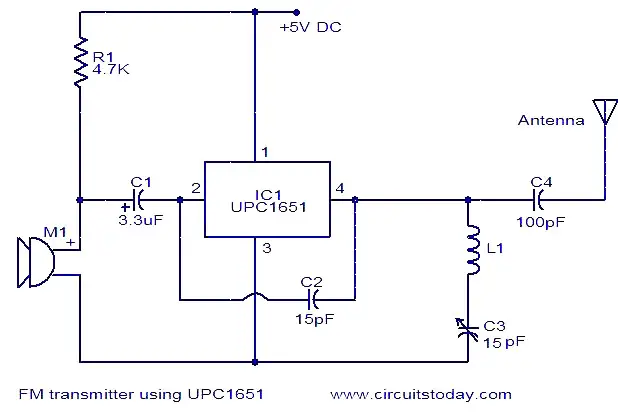 |
| Long range fm transmitter circuit diagram |
This is very stable, harmonic free, long range fm transmitter circuit which can be used for fm frequencies between 88 and 108 MHz. This can cover 5km range (long distance). It has a very stable oscillator because you use LM7809 stabilizer which is a 9V stabilized power supply for T1 transistor and for frequency adjustment that can be achieved by using the 10K linear potentiometer.
The output power of this long range rf transmitter is around 1W but can be higher if you use transistors like KT920A, BLX65, BLY81, 2N3553, 2SC1970, 2SC1971…
T1 is used as an oscillator stage to deliver a low power stable frequency. To adjust the freq. use the 10k linear potentiometer like this: if you trim down, towards ground, the freq. will drop and if you adjust it toward + it will rise. Basically the potentiometer is used as a variable power supply for the two BB139 varicap diodes. Those two diodes act like a variable capacitor when you adjust the pot. By varying the diode capacitance the L1 + diodes circuit makes a resonance circuit for T1. You can use transistors like BF199, BF214 but do not use BCs. At this moment you don’t have yet the long range fm transmitter because the power is quite low, no more than 0.5 mW.
T2 and T3 works as a buffer stage, T2 as a voltage amplifier and T3 as a current amp. This buffer stage is very important for freq stabilization because is a tampon circuit between the oscillator and the preamp and final amplifier. It is well known that poor transmitter designs tend to modify freq. as you adjust the final stage. With this T2, T3 stage this won’t happen anymore!
T4 is a preamplifier for the fm transmitter and is used as a voltage power rf amplifier and will deliver enough power to the final T5 transistor. As you can see T4 has a capacitor trimmer in its collector, this is used to make a resonance circuit that will force T4 to amplify better and get rid of those unwanted harmonics. L2 and L3 coils must be at 90 degrees angle one to another, this is to avoid frequency and parasite coupling.
The final stage of the long range rf transmitter is equiped with any rf power transistor that has at least 1 watt output power. Use transistors like 2N3866, 2N4427, 2N3553, BLX65, KT920A, 2N3375, BLY81, 2SC1970 or 2SC1971 if you want to have a pro fm transmitter with enough power to cover a long range area. If you use 2N2219 you will get no more than 400mW. Use a good heatsink for the T5 transistor as it gets a little hot. Use a good 12V/1Amp minimum stabilized power supply.
T1 = T2 = T3 = T4 = BF199
T5 = 2N3866, 2N4427 or 2SC1970 for 1Watt / 2SC1971, BLX65, BLY81, KT920A or 2N3553 for 1.5 to 2W power.
L1 = 5 turns / 0.6mm / 4mm silvered copper
L2 = 6 turns / 0.8mm / 6mm enamelled copper
L3 = 3 turns / 1mm / 7mm silvered copper
L4 = 6 turns / 1mm / 6mm enamelled copper
L5 = 4 turns / 1mm / 7mm silvered copper
Use silvered copper for L3 and L5 if you want to obtain better characteristics.
Adjustments of the long range transmitter
Start by construction the oscillator stage, solder a small wire to T1 10pF capacitor out and listening to a fm receiver, trim the 10k pot untill you can “hear” a blank noise or you you plug in an audio source you can hear the music. With a 70cm wire you can cover a 2 – 3 meter area just with the oscillator stage.
Then continue to build the rest of the rf transmitter, use proper shielding as indicated in the circuit schematic. When you finished the transmitter construction connect the antena or better a 50 or 75 Ω resistive load and use this rf probe, you can use 1N4148 diode instead of the probe diode.
Adjust again the 10k pot to desired freq. and then go to T4 stage and trim the first collector trimmer for maximum voltage indication on the multimeter. Then continue with the next trimmer and so on. Then go back to the first trimmer and readjust again untill you obtain the highest voltage on the multimeter. For 1 watt rf power you can measure a 12 to 16 Voltage. The formula is P (in watt) is equal to U
2 / Z, where Z is 150 for 75Ω resistor or 100 for 50Ω resistor, but you must remember that the real rf power is lower.
After those adjustment, if everything is going well connect the antenna, continue using the rf probe, readjust again all the trimmers starting from T3. Make sure you don’t have harmonics, check your TV and radio set to see if there is disturbance on the band. Check this in another room, far away from the fm transmitter or antenna.
That’s all folks

… This is my design for a long range transmiter and is working well. I used 2SC1971 which has a 12dB power gain in 88 … 108 MHz band, this is around 15 times rf amplification. As T4 delivers around 80 to 100 mW of rf power the final stage has enough power to deliver between 1 to 2W depending the transistor usage.




























